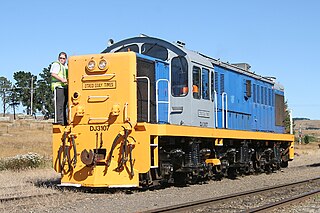
The New Zealand DJ class locomotive is a type of diesel-electric locomotive in service on the New Zealand rail network. The class were built by Mitsubishi Heavy Industries and introduced from 1968 to 1969 for the New Zealand Railways Department (NZR) with a modernisation loan from the World Bank to replace steam locomotives in the South Island, where all of the class members worked most of their lives. Nine of the locomotives remain in use, mainly with Dunedin Railways.
The Southerner was a passenger express train in New Zealand's South Island between Christchurch and Invercargill along the South Island Main Trunk, that ran from 1970 to 2002. It was one of the premier passenger trains in New Zealand and its existence made Invercargill the southernmost passenger station in the world.

The NZR RM class Edison battery-electric railcar was a railcar that ran in Canterbury, New Zealand for eight years. It was built for New Zealand Railways (NZR) as a prototype for battery-electric railcars. While the railcar, classified "RM 6", was considered the first successful railcar in New Zealand, it was later destroyed in a fire, and battery-electric traction for railcars was not developed further in New Zealand. Two other classes of battery-electric locomotives were introduced about the same time as RM 6, the E class of 1922 and the EB class of 1925.

The NZR RM class Midland railcar was the first successful railcar, and first diesel-powered vehicle, to enter revenue service in New Zealand. Two were built, RM 20 and RM 21, and they ran for five years from 1936 to 1941 before being replaced by larger Vulcan railcars. They operated primarily on the Midland Line and the Greymouth-Hokitika portion of the Ross Branch

The NZR RM class McEwan Pratt petrol rail motor was the first rail motor to run on New Zealand's national rail network, though it was never used in revenue service. It was built in 1912 at a time when the New Zealand Railways Department (NZR) was seeking alternative methods of providing rural passenger transportation. "Mixed" trains that carried both passengers and freight were typical on country branch lines as there was not sufficient traffic to justify a separate passenger train, but the schedule delays caused by loading and unloading freight during the journey made the mixed trains undesirable.

The NZR RM class Model T Ford railcar was a type of rail motor that operated on New Zealand's national rail network. Only two were built, classified as RM 4 and RM 5, and they were experimental railcars designed in an attempt to offer improved passenger services on quiet country branch lines that served regions with small populations.
The New Zealand Railways Department, NZR or NZGR and often known as the "Railways", was a government department charged with owning and maintaining New Zealand's railway infrastructure and operating the railway system. The Department was created in 1880 and was corporatised on 1 April 1982 into the New Zealand Railways Corporation. Originally, railway construction and operation took place under the auspices of the former provincial governments and some private railways, before all of the provincial operations came under the central Public Works Department. The role of operating the rail network was subsequently separated from that of the network's construction. From 1895 to 1993 there was a responsible Minister, the Minister of Railways. He was often also the Minister of Public Works.
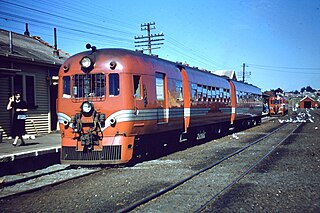
The NZR RM class 88-seaters were a class of railcar used in New Zealand. New Zealand Government Railways (NZR) classed them RM , the notation used for all railcars, numbering the 35 sets from RM100 to RM134. They were the most numerous railcars in NZR service, and were known unofficially as "Articulated", "Eighty Eights", "Twinsets", "Drewrys" or "Fiats". Their purchase and introduction saw the demise of steam-hauled provincial passenger trains and mixed trains.
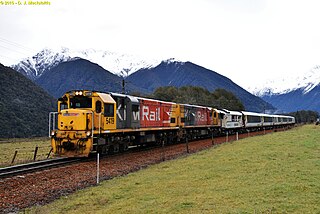
The TranzAlpine is a passenger train operated by The Great Journeys of New Zealand in the South Island of New Zealand over the Midland Line; often regarded to be one of the world's great train journeys for the scenery through which it passes. The journey is 223 kilometres (139 mi) one-way, taking almost five hours. There are 16 tunnels and four viaducts, with the Staircase Viaduct elevated as much as 75 metres (246 ft).

The NZR JA class were a type of 4-8-2 steam locomotive used on the New Zealand railway network. The class was built in two batches, the first batch was built at Dunedin's Hillside Workshops between 1946 and 1956 and the second batch by the North British Locomotive Works in 1951. To distinguish between the batches, locomotives are identified by their maker.
This is a list of jargon commonly used by railfans and railway employees in New Zealand.

The Midland line is a 212 km section of railway between Rolleston and Greymouth in the South Island of New Zealand. The line features five major bridges, five viaducts and 17 tunnels, the longest of which is the Otira tunnel. It is the route of the popular TranzAlpine passenger train.

The NZR LA class was a class of 4-4-0T steam locomotives used by the New Zealand Railways Department and the New Zealand Midland Railway Company. They were built by Nasmyth, Wilson and Company in 1887 for New Zealand Midland Railway Company, and were taken over by NZR in 1900, when the government acquired the incomplete Midland line. The designation also applies to the NZR 4-4-0Trebuilds of the Avonside L class of 1875 which were later reclassified LB after being rebuilt as 4-4-2Ts.

The New Zealand DG and DH class locomotive were a type of diesel-electric locomotives in operation on New Zealand's rail network from 1955-1983, built by English Electric.

The Stillwater Ngākawau Line (SNL), formerly the Stillwater–Westport Line (SWL) and the Ngakawau Branch, is a secondary main line, part of New Zealand's national rail network. It runs between Stillwater and Ngakawau via Westport on the West Coast of the South Island. It was one of the longest construction projects in New Zealand's history, with its first section opened in 1889 but the full line not completed until 1942.
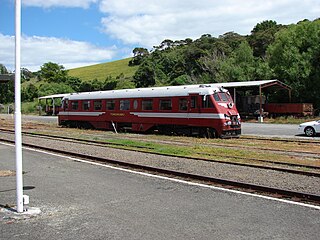
The NZR RM class Standard railcars were a class of railcar operated by the New Zealand Railways Department (NZR) in the North Island of New Zealand. Officially classified as RM like all other railcar classes in New Zealand, they acquired the designation of "Standard" to differentiate them from other railcar classes. They were introduced in 1938 and withdrawn in 1972.
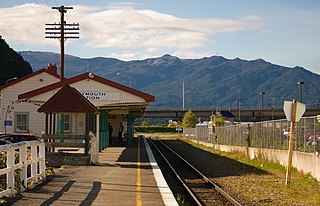
The Ross Branch, officially known as the Hokitika Line since 2011, and previously as the Hokitika Industrial Line, is a branch line railway that forms part of New Zealand's national rail network. It is located in the Westland District of the South Island's West Coast region and opened to Hokitika in 1893. A further extension to Ross operated from 1909 until 1980.
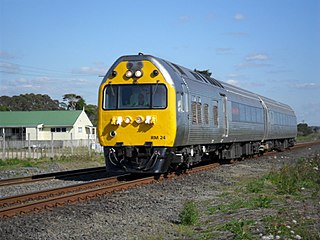
The RM class was the classification used by the New Zealand Railways Department (NZR) and its successors gave to most railcars and railbuses that have operated on New Zealand's national rail network. "RM" stands for Rail Motor. As many types of railcars are operated, class names have been given to each railcar type to differentiate them from others.
The Picton Express was a passenger express train operated by the New Zealand Railways Department (NZR) between Christchurch and Picton. It ran from December 1945 until February 1956, and was thus the shortest-lived provincial express in New Zealand. Following the end of railcar services in 1976, a new carriage train between Christchurch and Picton began, under the same name as the earlier service, until it was replaced in 1988 by the Coastal Pacific Express.

Stillwater is a town in the South Island of New Zealand east of Greymouth on the banks of the Grey River, at the confluence with the Arnold River, in the Grey District of the West Coast, next to Brunner. There is also Stillwater, Auckland in the North Island.















